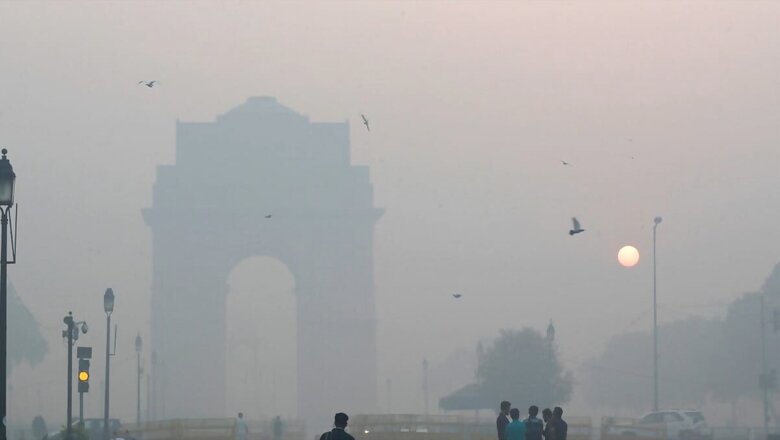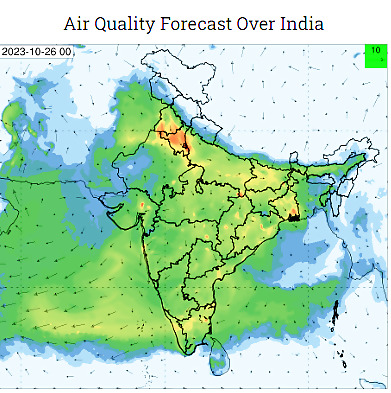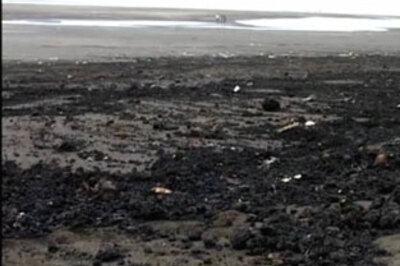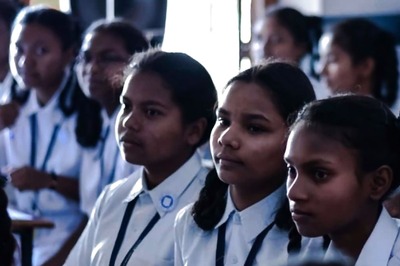
views
As temperatures drop, the air quality across the National Capital Region (NCR) has begun to deteriorate. The Air Quality Index (AQI) was recorded at 263 (poor) on Monday but is likely to breach the 300 mark (very poor) after the festivities on Tuesday evening.
According to the air quality forecast issued by the Indian Institute of Tropical Meteorology (IITM), Pune, the AQI is likely to hover above ‘poor’ to ‘very poor’ levels over the next few days, with a significant drop on Wednesday morning. No rainfall activity is predicted over the week, and the skies are expected to be clear with mist in the mornings. The night temperatures have dropped to 17℃ in Delhi, and the winds are predominantly blowing from northwest India where the stubble burning incidents have shot up again. However, the wind speed remains moderate, 6-10 kmph, and usually calm during the night hours. A wind speed of less than 10 kmph generally leads to stagnation of the existing pollutants and causes a spike in pollution levels.


The high levels of pollution have predisposed millions of people living in the National Capital Region (NCR) to respiratory illness which manifests in multiple ways. While the air remains polluted all through the year, it spikes to dangerous levels during winter, when a thick layer of toxic smog envelops the entire region. Doctors warn that people may start experiencing general breathing discomfort after prolonged exposure when the AQI drops to ‘poor’ and starts worsening thereafter.
VEHICULAR POLLUTION MAIN SOURCE
Since 40% of Delhi’s pollution comes from vehicles, the Commission for Air Quality Management in NCR and Adjoining Areas (CAQM) has already issued an advisory. According to it, all buses, whether government or private, originating from the NCR areas in the neighbouring states and travelling to Delhi, be either Electric Vehicles (EVs) or CNG or BS-VI diesel with effect from November 1.
Haryana, Uttar Pradesh, and Rajasthan have also formulated action plans to replace or relocate their older BS-III and BS-IV diesel-operated buses in a phased manner and procure the BS-VI buses. While Haryana plans to procure around 1,313 new BS VI buses, Rajasthan has plans for 590 new ones, while UP has targeted more than 1,650 new diesel buses by March 2024.
GRAP 2 ENFORCED
Grade 2 of the Graded Response Action Plan (GRAP) has already been enforced in the national capital, anticipating a drop in the air quality during the festive period. GRAP is enforced three days in advance of the AQI reaching the projected levels of that stage. Stage one of the Graded Response Action Plan (GRAP) kicks in when AQI enters the poor category (AQI 201-300) and Grade 2 when the AQI is 300-400. Grade 3 is enforced when AQI breaches the 400 mark and Grade 4 when it becomes ‘severe +’ crossing the 450 mark.
If the AQI crosses the 400 mark (severe), under GRAP 3, then all state government schools in Delhi would be advised to take a decision on discontinuing physical classes in schools up to class 5. The state governments will also be required to impose strict restrictions on the plying of BS-III petrol and BS-IV diesel four-wheelers in Delhi, Gurugram, Noida, Faridabad, and Ghaziabad if the air quality turns severe.
Meanwhile, 319 incidents of stubble burning have been reported in the last 24 hours in the neighbouring states, including Punjab (152), Haryana (29), UP (20), Madhya Pradesh (89), and 29 in Rajasthan. Overall, as many as 4,693 fire counts have been reported from across northwest India since the paddy harvesting season began on September 15. While Punjab leads with 1,976 cases, it is followed by Madhya Pradesh (970), and Haryana (743).



















Comments
0 comment